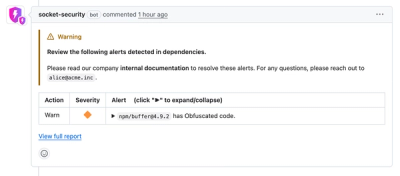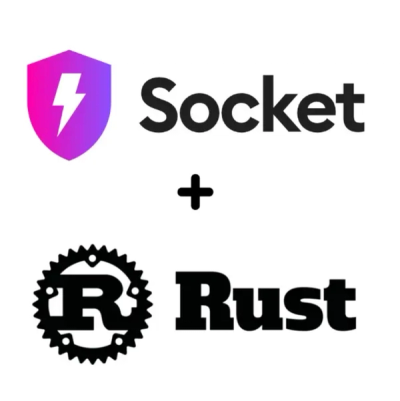
Security News
Crates.io Users Targeted by Phishing Emails
The Rust Security Response WG is warning of phishing emails from rustfoundation.dev targeting crates.io users.
Returns true if a value exists, false if empty. Works with deeply nested values using object paths.
The has-value npm package is used to check if a value exists, is not empty, or is not undefined. It is useful for validating data and ensuring that required fields are populated.
Check if a value exists
This feature checks if a given value exists. In this example, the string 'Hello World' is checked, and since it is a non-empty string, the result is true.
const hasValue = require('has-value');
console.log(hasValue('Hello World')); // trueCheck if an object property has a value
This feature checks if a specific property of an object has a value. In this example, the object has a property 'name' with a value 'John Doe', so the result is true.
const hasValue = require('has-value');
const obj = { name: 'John Doe' };
console.log(hasValue(obj, 'name')); // trueCheck if an array has a value
This feature checks if an array has any values. In this example, the array [1, 2, 3] is checked, and since it contains elements, the result is true.
const hasValue = require('has-value');
const arr = [1, 2, 3];
console.log(hasValue(arr)); // trueCheck if a nested object property has a value
This feature checks if a nested property within an object has a value. In this example, the nested property 'user.name' is checked, and since it has a value 'Jane Doe', the result is true.
const hasValue = require('has-value');
const nestedObj = { user: { name: 'Jane Doe' } };
console.log(hasValue(nestedObj, 'user.name')); // trueLodash is a popular utility library that provides a wide range of functions for manipulating arrays, objects, and other data types. It includes a method `_.has` to check if a property exists in an object, which is similar to the functionality provided by has-value.
Underscore is another utility library similar to Lodash. It provides a method `_.has` to check if an object contains a given property. While it does not specifically check for non-empty values, it can be used in combination with other methods to achieve similar results.
Validator is a library for string validation and sanitization. It includes methods to check if a string is empty or not, which can be used to validate the presence of values in a similar way to has-value.




Returns true if a value exists, false if empty. Works with deeply nested values using object paths.
Please consider following this project's author, Jon Schlinkert, and consider starring the project to show your :heart: and support.
Install with npm:
$ npm install --save has-value
Breaking changes in v2.0! See the release history for details.
const has = require('has-value');
console.log(has()) //=> true
console.log(has('foo')) //=> true
Works for:
isEmpty
To do the opposite and test for empty values, do:
const isEmpty = (...args) => !has(...args);
console.log(has({ foo: { bar: ['a'] } }, 'foo.bar')); //=> true
console.log(has({ foo: { bar: [0] } }, 'foo.bar')); //=> true
console.log(has({ foo: { bar: [[[]]] } }, 'foo.bar')); //=> false
console.log(has({ foo: { bar: [[], []] } }, 'foo.bar')); //=> false
console.log(has({ foo: { bar: [] } }, 'foo.bar')); //=> false
console.log(has({ foo: { bar: true } }, 'foo.bar')); //=> true
console.log(has({ foo: { bar: false } }, 'foo.bar')); //=> true
console.log(has({ foo: { bar: new Buffer() } }, 'foo.bar')); //=> false
console.log(has({ foo: { bar: new Buffer('foo') } }, 'foo.bar')); //=> true
Dates are always true.
console.log(has({ foo: { bar: new Date() } }, 'foo.bar')); //=> true
Returns false if err.message is an empty string.
console.log(has({ foo: { bar: new Error() } }, 'foo.bar')); //=> false
console.log(has({ foo: { bar: new Error('foo') } }, 'foo.bar')); //=> true
Functions are always true.
console.log(has({ foo: { bar: function(foo) {} } }, 'foo.bar')); //=> true
console.log(has({ foo: { bar: function() {} } }, 'foo.bar')); //=> true
console.log(has({ foo: { bar: new Map() } }, 'foo.bar')); //=> false
console.log(has({ foo: { bar: new Map([['foo', 'bar']]) } }, 'foo.bar')); //=> true
null is always true, as it's assumed that this is a user-defined value, versus undefined which is not.
console.log(has({ foo: { bar: null } }, 'foo.bar')); //=> true
console.log(has({ foo: { bar: {} } }, 'foo.bar')); //=> false
console.log(has({ foo: { bar: { a: 'a' }} } }, 'foo.bar')); //=> true
console.log(has({ foo: { bar: { foo: undefined } } }, 'foo.bar')); //=> false
console.log(has({ foo: { bar: { foo: null } } }, 'foo.bar')); //=> true
console.log(has({ foo: { bar: 1 } }, 'foo.bar')); //=> true
console.log(has({ foo: { bar: 0 } }, 'foo.bar')); //=> true
console.log(has({ foo: { bar: new RegExp() } }, 'foo.bar')); //=> false
console.log(has({ foo: { bar: new RegExp('foo') } }, 'foo.bar')); //=> true
console.log(has({ foo: { bar: new Set() } }, 'foo.bar')); //=> false
console.log(has({ foo: { bar: new Set(['foo', 'bar']) } }, 'foo.bar')); //=> true
console.log(has({ foo: { bar: 'a' } }, 'foo.bar')); //=> true
console.log(has({ foo: { bar: '' } }, 'foo.bar')); //=> false
console.log(has({ foo: { bar: } }, 'foo.bar')); //=> false
console.log(has({ foo: { bar: void 0 } }, 'foo.bar')); //=> false
console.log(has({ foo: { bar: undefined } }, 'foo.bar')); //=> false
Breaking changes
zero always returns truearray now recurses, so that an array of empty arrays will return falsenull now returns truePull requests and stars are always welcome. For bugs and feature requests, please create an issue.
Running and reviewing unit tests is a great way to get familiarized with a library and its API. You can install dependencies and run tests with the following command:
$ npm install && npm test
(This project's readme.md is generated by verb, please don't edit the readme directly. Any changes to the readme must be made in the .verb.md readme template.)
To generate the readme, run the following command:
$ npm install -g verbose/verb#dev verb-generate-readme && verb
You might also be interested in these projects:
'a.b.c') paths. | homepage| Commits | Contributor |
|---|---|
| 32 | jonschlinkert |
| 2 | rmharrison |
| 1 | wtgtybhertgeghgtwtg |
Jon Schlinkert
Copyright © 2018, Jon Schlinkert. Released under the MIT License.
This file was generated by verb-generate-readme, v0.6.0, on March 03, 2018.
FAQs
Returns true if a value exists, false if empty. Works with deeply nested values using object paths.
The npm package has-value receives a total of 17,168,248 weekly downloads. As such, has-value popularity was classified as popular.
We found that has-value demonstrated a not healthy version release cadence and project activity because the last version was released a year ago. It has 1 open source maintainer collaborating on the project.
Did you know?

Socket for GitHub automatically highlights issues in each pull request and monitors the health of all your open source dependencies. Discover the contents of your packages and block harmful activity before you install or update your dependencies.

Security News
The Rust Security Response WG is warning of phishing emails from rustfoundation.dev targeting crates.io users.

Product
Socket now lets you customize pull request alert headers, helping security teams share clear guidance right in PRs to speed reviews and reduce back-and-forth.

Product
Socket's Rust support is moving to Beta: all users can scan Cargo projects and generate SBOMs, including Cargo.toml-only crates, with Rust-aware supply chain checks.